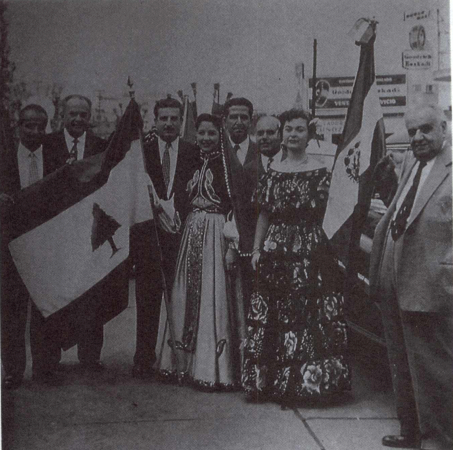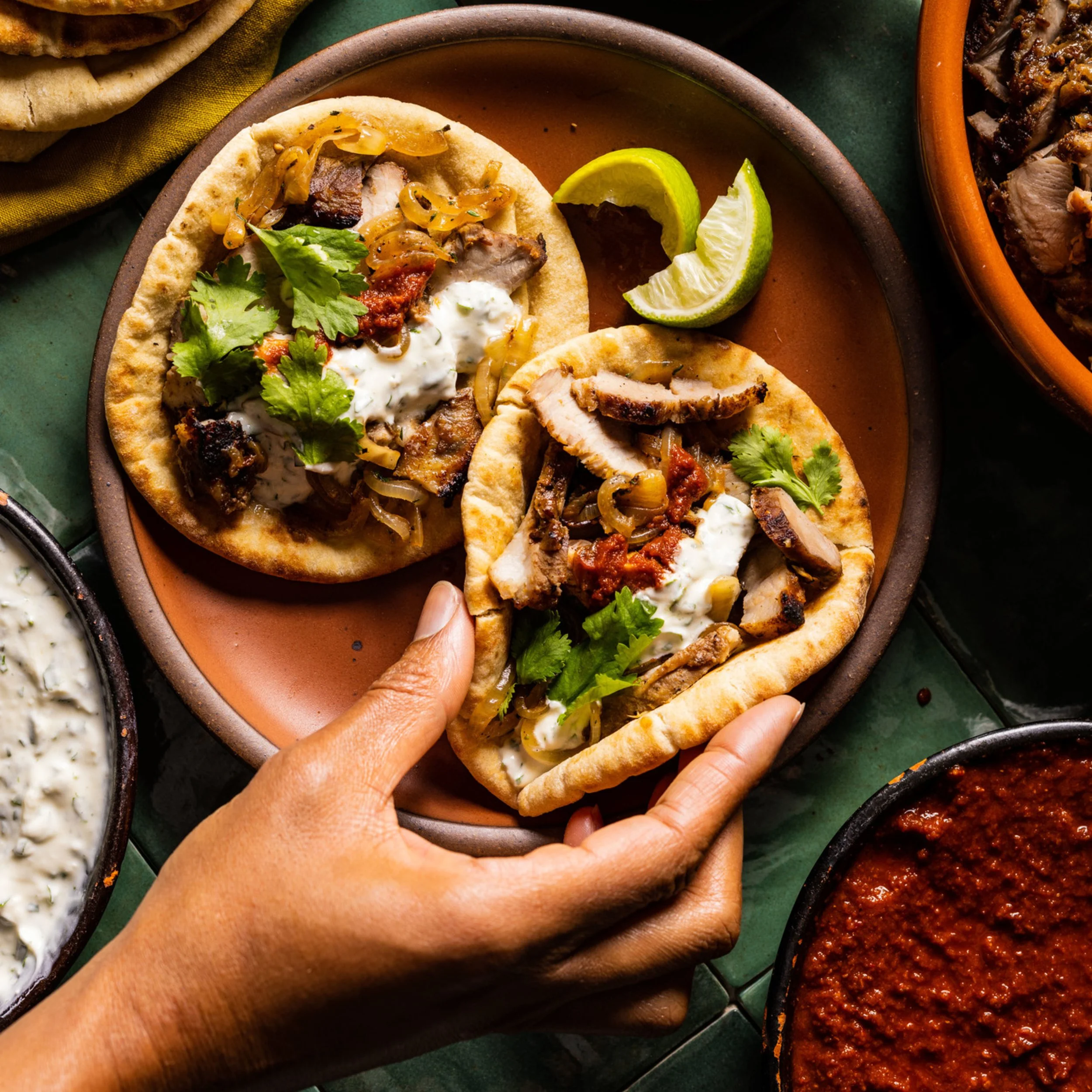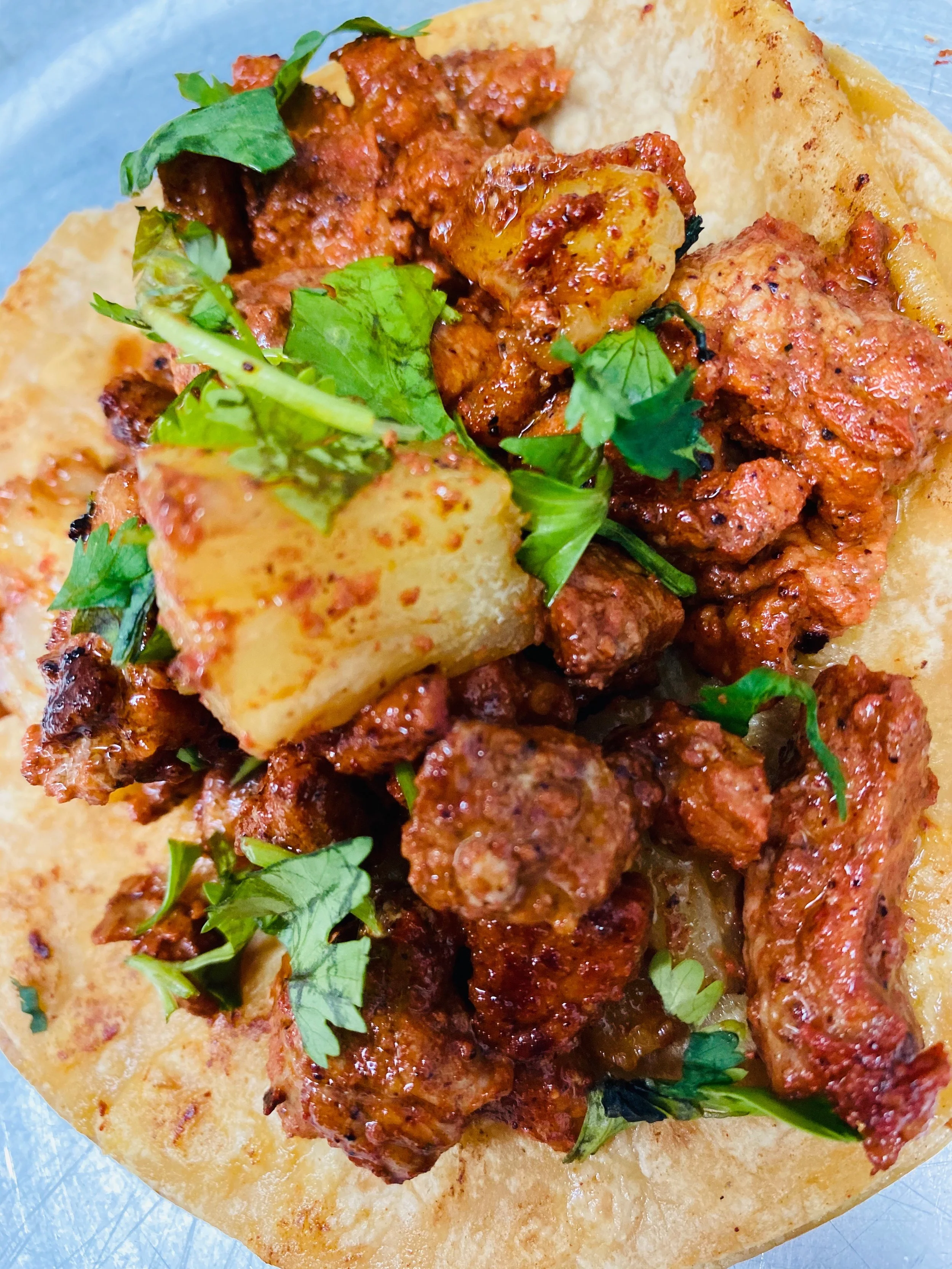History of the Al Pastor Taco: A Comprehensive Journey from Lebanese Shawarma to Mexican Street Food Icon
The al pastor taco represents one of Mexico's most beloved street foods, yet its fascinating history reveals a remarkable story of cultural migration, culinary adaptation, and international fusion that spans continents and centuries. This iconic dish, characterized by marinated pork cooked on a vertical spit and served with onions, cilantro, pineapple, and salsa, exemplifies how immigration and cultural exchange can create entirely new culinary traditions.
The Lebanese Migration Wave to Mexico
The origins of al pastor can be traced directly to a significant wave of Middle Eastern immigration to Mexico during the late 19th and early 20th centuries. Between 1880 and 1950, over 100,000 Arabic speakers, predominantly from Lebanon, arrived in Mexico seeking economic opportunity and fleeing political instability in their homeland. Research indicates that the first documented Lebanese immigrant, R.P. Boutros Raffoul, arrived in Mexico as early as 1878, followed by Joseph M. Abad in 1881 and Santiago Saouma Adued, who settled in Mérida in 1882.
Celebrating Lebanese Independence Day outside the Lebanese embassy in Mexico City. Courtesy of UNAM.
This migration was driven by multiple factors: the oppression of the Ottoman regime with its political instability, economic competition, and religious tensions. The Lebanese immigrants were attracted to Mexico by President Porfirio Díaz's development initiatives that actively encouraged foreign immigration as part of his modernization program. During the 1930s, although Lebanese immigrants constituted less than 5% of Mexico's total immigrant population, they remarkably accounted for approximately 50% of all immigrant economic activity. Text continues after popular blog posts section below.
popular blog posts
The demographic composition of these Lebanese immigrants was diverse: 64% were Catholic, 18% were Jewish, 4.6% were Muslim, 6% were Orthodox, and 2% were Druze. Most importantly for the development of al pastor, many were Maronite Christians who had no religious dietary restrictions regarding pork consumption.
Mix of two cultures. Courtesy of UNAM.
From Shawarma to Tacos Árabes: The First Adaptation
Lebanese immigrants brought with them their traditional shawarma cooking technique - lamb cooked on a vertical rotisserie called a spit. The word "shawarma" itself derives from the Turkish word "çevirme," meaning "turning," reflecting its Ottoman Empire origins. Initially, Lebanese restaurateurs in Mexico attempted to recreate their traditional dishes exactly as they knew them, using lamb and serving the meat on pita-like flatbread called "pan árabe."
However, by the 1920s and 1930s, significant adaptations began to emerge. The first major change was the replacement of lamb with pork, which was more readily available and affordable in Mexico. Lebanese-Mexican restaurateurs also began incorporating local Mexican flavors and ingredients into their marinades, creating what became known as "tacos árabes" (Arab tacos).
The city of Puebla became the epicenter of this culinary evolution. Historical accounts indicate that tacos árabes were first served at establishments like Tacos Árabes Bagdad and Antigua Taqueria La Oriental in the 1930s. These early versions maintained the Lebanese influence through their cooking method and the use of pita-like bread, but incorporated Mexican preferences for pork and local seasonings.
The Evolution of the Vertical Spit Technology
The introduction and refinement of the vertical rotisserie (trompo) technology was crucial to al pastor's development and popularity. In Mexico, this vertical spit became known as a "trompo" - literally meaning "spinning top" in Spanish. The vertical orientation offered several technological advantages over traditional horizontal spits:
El Trompo - Frida’s Cocina
Even cooking: The vertical arrangement allowed rendered fat to continuously baste the meat as it rotated
Space efficiency: Maximum meat capacity in a minimal footprint, ideal for street vendors
Continuous service: Outer layers could be carved off while inner layers continued cooking
Self-basting mechanism: Fat naturally dripped down, keeping lower layers moist and flavorful
The trompo's design became increasingly sophisticated, with meat stacked in a cone shape - wider at the top to account for heat radiating upward, ensuring more even cooking throughout the vertical column. Modern trompo equipment features stainless steel construction for food safety and durability, along with gas or electric heating systems for consistent temperature control. The optimal cooking temperature for al pastor on a trompo ranges between 250-300°F, allowing the outer layers to develop a caramelized crust while the interior remains moist and tender.
The Birth of Tacos Al Pastor in Mexico City
The transformation from tacos árabes to tacos al pastor occurred when this cooking technique migrated from Puebla to Mexico City in the 1950s and 1960s. This transition marked several crucial changes:
Name Evolution
The dish adopted the name "tacos al pastor" - literally "shepherd-style tacos" - referencing the Lebanese immigrants' presumed pastoral background and the association of vertical spit cooking with shepherds in Middle Eastern traditions.
Recipe Modifications
Mexico City versions underwent significant recipe changes:
Enhanced marinades: The subtle flavors of tacos árabes were intensified with more complex spice blends
Achiote paste: This indigenous Mexican ingredient became central, providing the characteristic red color and earthy flavor
Citrus components: Sour orange and other citrus fruits were added for acidity and tenderizing properties
Spice complexity: Cinnamon, Mexican oregano, and other spices created the distinctive sweet-savory profile
Al Pastor marinade
Tortilla Transition
Perhaps most significantly, the pita-like bread was replaced with traditional Mexican corn tortillas, completing the dish's transformation into a recognizably Mexican taco.
The Complex Marinade: Science and Tradition
Modern al pastor marinades represent a sophisticated blend of Lebanese techniques and Mexican ingredients. The scientific precision behind these marinades involves specific temperature and time parameters. Professional taqueros typically marinate the meat for 24-48 hours, allowing the acids from citrus and vinegar to break down tough connective tissues while the enzymatic action of pineapple's bromelain further tenderizes the protein. The optimal internal cooking temperature for al pastor reaches 180-190°F, creating meat that is tender enough to slice thinly while maintaining structural integrity.
Traditional recipes typically include:
Primary Chili Components
Guajillo chiles: Providing sweet, tangy flavor with mild heat
Ancho chiles: Contributing smoky depth and rich color
Chipotle chiles: Adding smoky heat and complexity
Indigenous Mexican Elements
Achiote paste: Made from ground annatto seeds, providing earthy flavor and characteristic red coloring
Mexican oregano: Distinct from Mediterranean oregano, offering floral, citrusy notes
Fresh pineapple: Serving dual purposes as a meat tenderizer and flavor enhancer
Acid and Liquid Components
Orange juice: Fresh citrus for acidity and sweetness
White or apple cider vinegar: Additional acidity for tenderization
Pineapple juice: Extra enzymes for meat breakdown
Spice Blend
Cumin: Earthy, warming flavor
Black peppercorns: Heat and complexity
Cloves: Aromatic sweetness
Bay leaves: Herbal depth
Regional Variations Across Mexico
As al pastor spread throughout Mexico, distinct regional variations emerged:
Tacos de Trompo (Monterrey Style)
In Monterrey and northern Mexico, the dish became known as "tacos de trompo" and underwent several name changes before stabilization. According to scholar Domingo García Garza, these were introduced to Monterrey in 1962 by taquero Julio Reyna. The preparation was initially called "tacos griego" (from gyro) and "tacos Doneraki" (from doner kebab), directly acknowledging their Middle Eastern heritage.
Northern variations often feature:
Pink-colored marinades rather than deep red
Different spice profiles emphasizing paprika and other regional preferences
Flour tortillas in some areas, reflecting northern Mexican tortilla preferences
Puebla's Continued Taco Árabe Tradition
Puebla maintained its original tacos árabes tradition alongside the newer al pastor style.
These retain:
Thicker tortillas resembling pita bread
Simpler marinades closer to original Lebanese preparations
Less complex spicing compared to Mexico City versions
Tacos Arabes
popular blog posts
The Mystery of Pineapple
One of the most distinctive and puzzling aspects of al pastor is the inclusion of pineapple, both in marinades and as a garnish. Notably, this ingredient appears to have no direct Lebanese precedent. Several theories exist for its incorporation:
Enzymatic tenderization: Pineapple contains bromelain, a natural meat tenderizer
Flavor balance: Sweetness to counteract spicy chiles and acidic marinades
Regional adaptation: Possible influence from other Mexican culinary traditions
Innovation: Creative addition by second-generation Lebanese-Mexican cooks
The pineapple is traditionally placed at the top of the trompo, where it caramelizes from the heat while flavoring the meat below. When roasted separately, pineapple should be cooked at 375°F until the edges brown and caramelize, creating the perfect balance of sweet and smoky flavors that complement the rich, spiced meat.
Al Pastor taco - Frida’s Cocina
Lebanese-Mexican Economic and Cultural Impact
The Lebanese-Mexican community's influence extended far beyond cuisine. Carlos Slim Helú, born in 1940 to Lebanese immigrant parents, became one of the world's wealthiest individuals, with his business empire accounting for approximately 40% of Mexico's entire stock market at its peak. His success exemplifies the broader economic integration and success of the Lebanese community in Mexico.
The Lebanese influence in Mexican culture manifests in numerous ways:
Culinary contributions: Beyond al pastor, Lebanese immigrants introduced dishes like kibbeh, tabbouleh, and various Middle Eastern preparations
Business acumen: Lebanese-Mexicans became prominent in commerce, retail, telecommunications, and construction
Cultural integration: High rates of intermarriage led to deep cultural blending while maintaining distinct traditions
Modern Al Pastor and Global Expansion
Today, al pastor stands as Mexico's most recognizable taco internationally. The taco industry in Mexico alone generates an estimated 50 billion pesos (2.46 billion dollars) annually, with al pastor consistently ranking as the most popular variety. In Mexico City, the average resident lives within 400 meters of a taquería, and the industry employs over 30,000 people in the capital, representing 57% of informal food sector jobs. Food delivery apps reported over 64 million taco orders in 2024, with al pastor leading at 7.5 million orders through DiDi Food alone.
The dish has spread throughout the United States, particularly in cities with large Mexican populations, while maintaining its essential characteristics. Modern innovations include:
Equipment Evolution
Contemporary trompo machines feature:
Stainless steel construction for food safety and durability
Gas or electric heating systems for consistent temperature control
Improved spit designs for better meat stacking and carving
Preparation Refinements
Extended marination periods (often 24-48 hours) for deeper flavor penetration
Precise spice ratios developed through generations of refinement
Temperature control techniques for optimal cooking
Cultural Recognition
Al pastor has gained recognition as a symbol of Mexican cultural identity and an example of successful culinary fusion. In 2010, UNESCO recognized Mexican cuisine as an Intangible Cultural Heritage of Humanity, acknowledging the historical and cultural importance of traditional cooking practices like those used in al pastor preparation. This recognition celebrates not only the food itself but also the communal aspects of food preparation and consumption that bind families and communities together.
The economic impact extends beyond traditional taquerías. The rise of food trucks specializing in al pastor has created a mobile economy where operators can generate between 3,000 to 8,000 dollars per week, depending on weather and location. These mobile operations serve as essential economic anchors in working-class communities, providing affordable, high-quality meals while creating entrepreneurial opportunities for immigrant families.
The Continuing Evolution
The story of al pastor continues to evolve as Mexican cuisine adapts to global markets and changing tastes. Modern variations include vegetarian versions using mushrooms or other proteins, fusion applications in upscale restaurants, and continued regional innovations throughout Mexico and internationally. The technique has inspired derivative dishes served on french fries, in burritos, and as toppings for nachos, demonstrating the versatility of this cooking method.
Contemporary taqueros have elevated al pastor preparation to an art form, with master practitioners capable of precise knife work that creates paper-thin slices while maintaining the meat's structural integrity. The rhythmic motion of carving meat from a rotating trompo has become a form of culinary theater, drawing crowds who appreciate both the skill involved and the superior flavor that results from proper technique.
The al pastor taco serves as a powerful reminder that authentic cuisine is not static but rather the result of continuous cultural exchange, adaptation, and innovation. From its origins in Ottoman Empire cooking techniques, through Lebanese immigration to Mexico, to its current status as an international icon of Mexican street food, al pastor represents the dynamic nature of culinary culture and the profound impact that migration and cultural mixing can have on a nation's food identity.
This remarkable dish stands as testimony to the Lebanese community's lasting contribution to Mexican culture and demonstrates how the collision of different culinary traditions can produce something entirely new yet respectful of its diverse origins. Whether enjoyed on the streets of Mexico City, in the original taquerías of Puebla, or in Lebanese-Mexican restaurants around the world, al pastor continues to tell the story of cultural synthesis, immigrant resilience, and the universal language of exceptional food.













